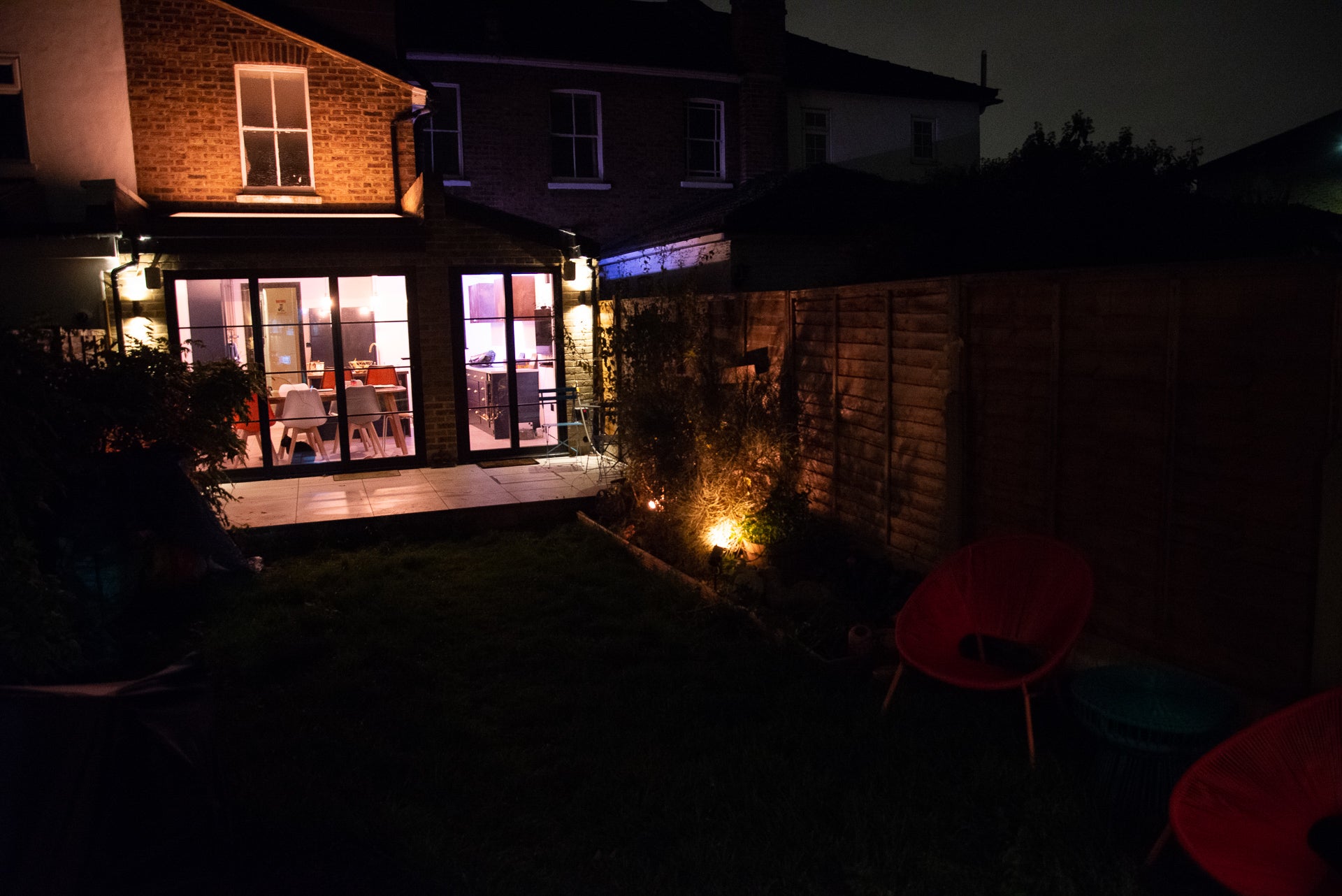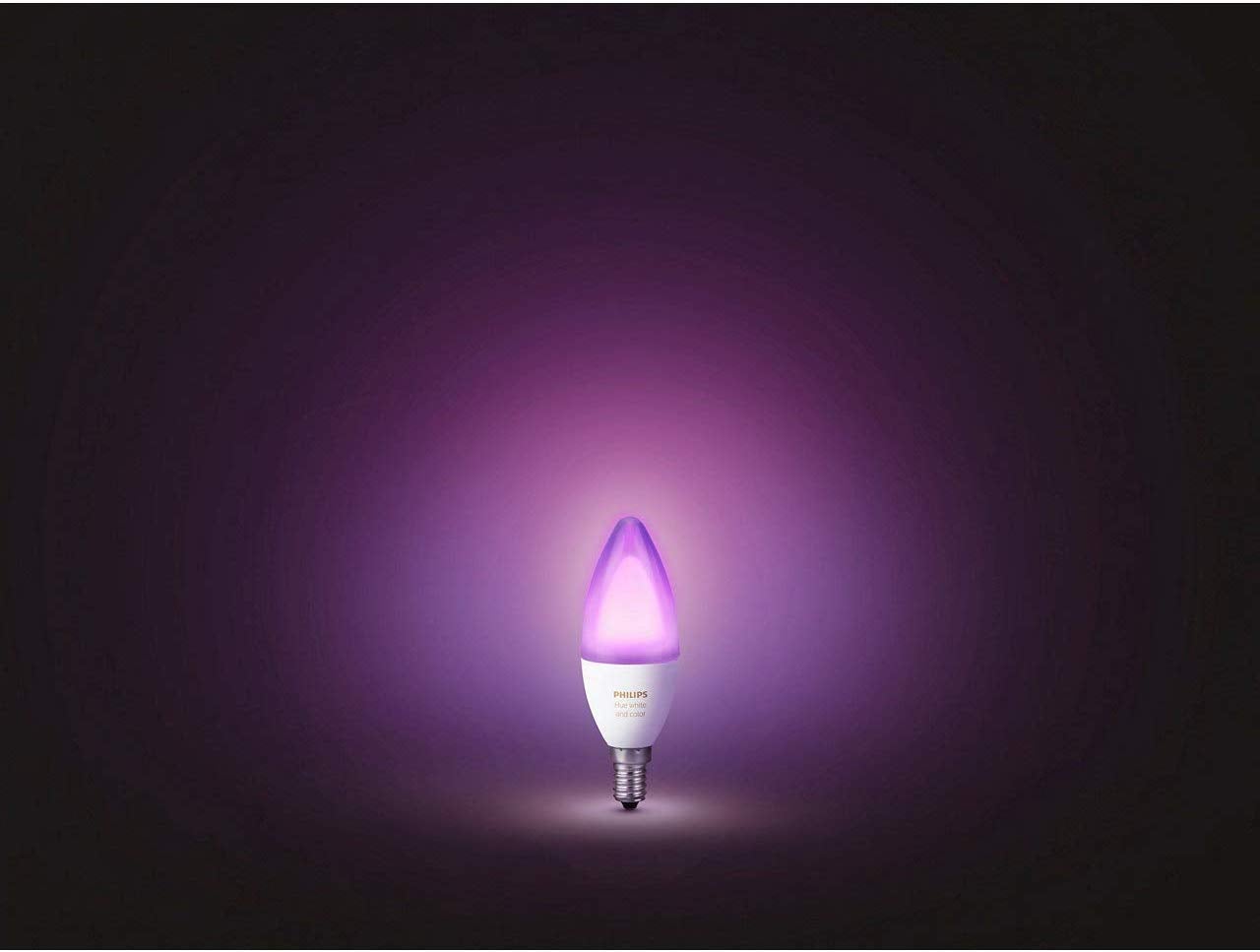Philips Hue Wall Switch Module Review
Turn your dumb switches into smart one
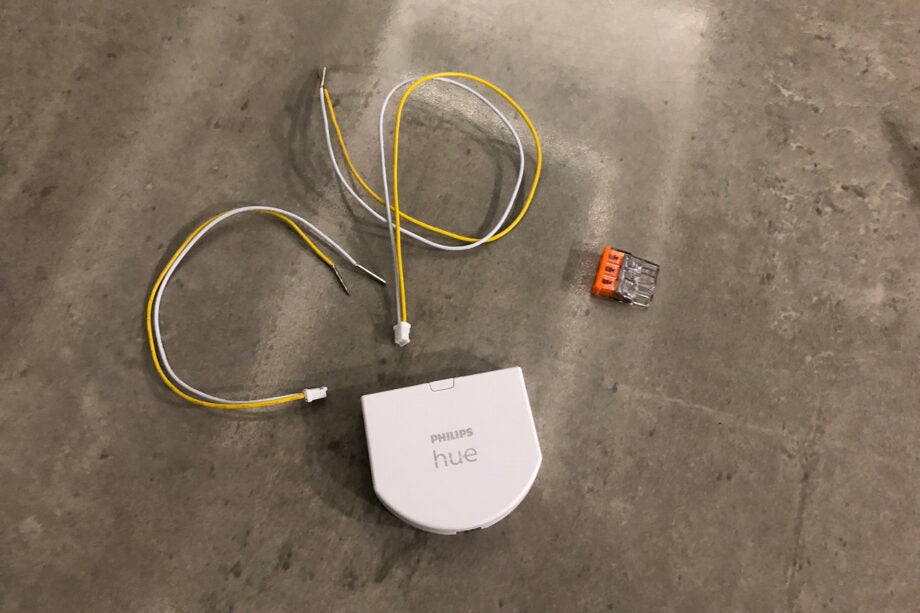

Verdict
A neat upgrade, the Philips Hue Wall Switch Module turns your dumb switches into smart ones. It’s relatively easy to install and gives a surprising amount of control. Having a battery-operated module may put some people off, but those that don’t want to spoil the look of their home with plastic smart switches will find this an excellent choice.
Pros
- Keeps your existing light switch
- Three programmable scenes
- Keeps power to your Hue bulbs
Cons
- No dimmer control
- Hard to get at battery
Availability
- UKRRP: £34.999
- USARRP: $34.99
Key Features
- Control optionsThis module keeps power to your Hue bulbs and can control lights in the room or zone of your choosing.
Introduction
If you’ve got a Philips Hue system, then I guarantee that you’ve suffered from this problem: someone has turned the light switch off, cutting power to your smart bulbs. This has long been an issue with Hue lights, but the Philips Hue Wall Switch Module is designed to fix this.
Fitting behind your light switch, the module keeps the power to your smart bulbs running permanently, while keeping your switch working the way it should. The trade-off is slightly imperfect control and more fiddly bulb changing, but in the right situation, this is a useful upgrade.
Design and installation
- Should fit easily into the wall box
- Battery-powered design
- Slightly more fiddly for lights with multiple switches
As Hue bulbs need power to work, they need the light switch to be left on. That’s usually alright, but visitors rarely seem to understand this, and I always find that my lights are turned off at the switch when guests have been.
Even if the light switch is left alone, having physical control for your lights means that you need to put a Hue wireless switch somewhere (such as the Hue Dimmer Switch or Senic Friends of Hue Smart Switch). Often, the best place to put one of these is next to your existing light switch, which doesn’t look particularly nice.
The Philips Hue Wall Switch Module solves both problems but needs a bit of electrical know-how to get it to work, as you need to rewire your light switch, which means turning the power off.
First, there’s the push-in wire connector. This should have the live cables from your existing light switch pushed into it, forming a permanent connection. If you have a single light switch that should be two cables; a double switch should have three live cables. Do not insert neutral cables or earth cables into this connector.
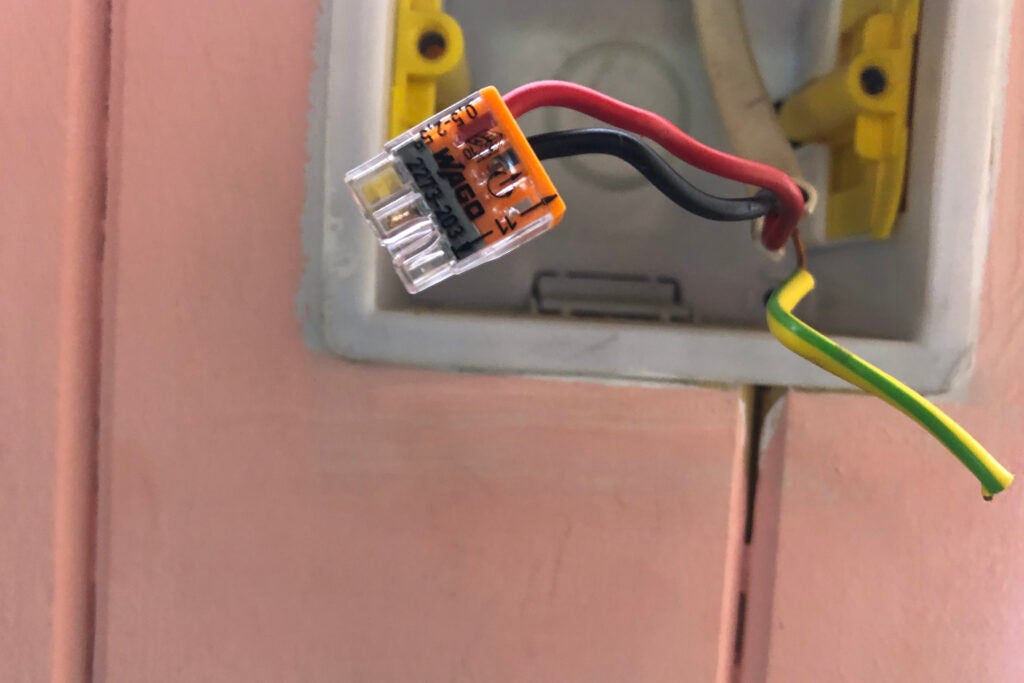
Once done, your light bulbs will have permanent power when you reconnect the power. If you’re changing the bulb in the future, you’ll need to turn off the mains power at the consumer unit.
Next, is the wall switch module. This is a battery-powered module that connects to your Hue Bridge via Zigbee, running off a CR2450 battery that Philips says should last around five years. Once the battery dies, you’ll have to take the light switch off the wall to replace the battery. In this way, the Philips Hue Wall Switch Module is less convenient than a regular light switch.
This module comes with cables and plugs to connect up to two switches. If you have a lighting circuit with two or three switches, you’ll need additional Philips Hue Wall Switch Modules (one for each switch), plus you may need a push-in connector with four inputs.
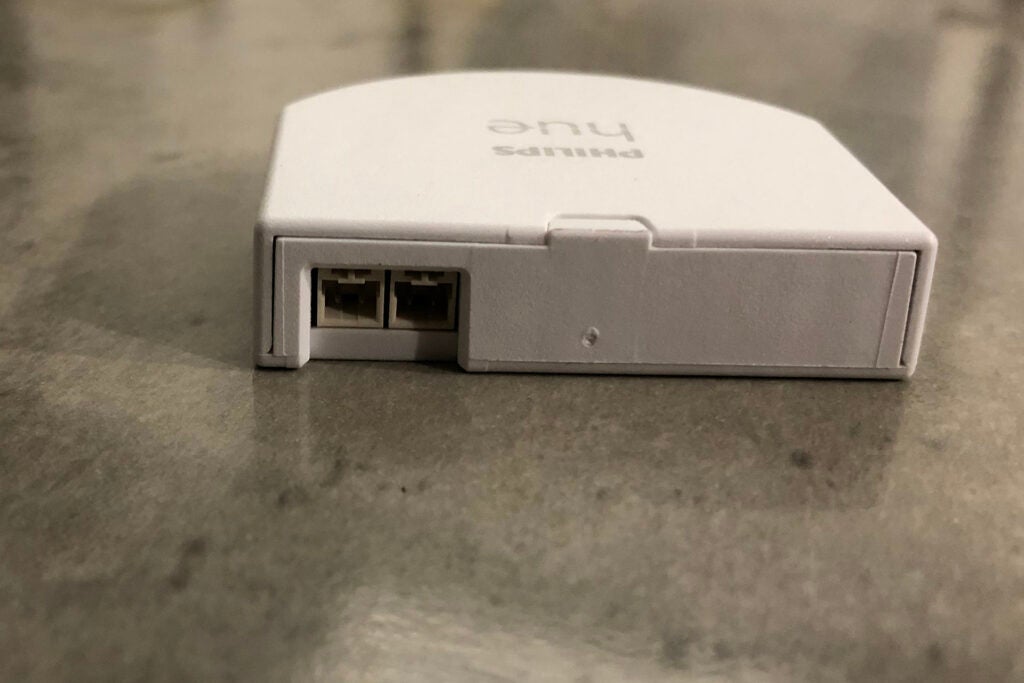
To wire up a switch, you plug in the cable connector and then attach the wires to the same ports on your light switch that the live wires went into. It’s worth taking a picture of your existing setup to refer to.
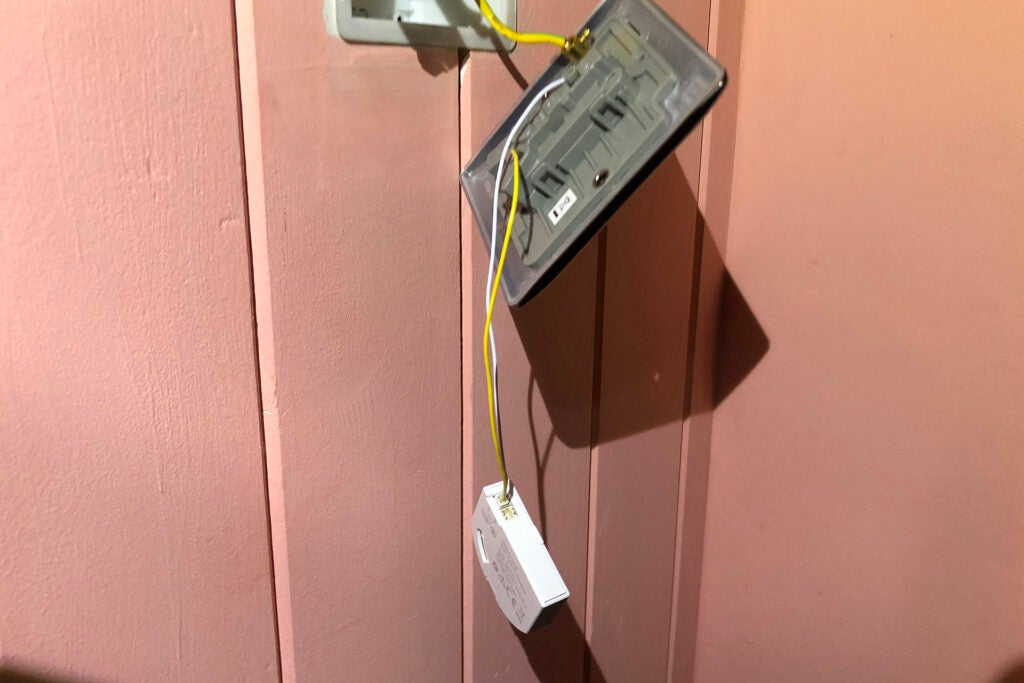
Having a battery-powered switch may seem like madness, given that there’s power at the switch. The main argument for using batteries and hardwiring the light is that most light switches don’t have neutral cables to them. Without a neutral cable, when the switch is turned off, the connected device loses power.
Now, there are smart light switches that don’t require a neutral cable, but they work in a slightly different way. When they’re set to ‘off’ they leave a small amount of power running through the switch (effectively, like a dimmer set to its lowest setting). I wouldn’t use one of these switches with Hue bulbs, as Philips doesn’t recommend using a dimmer switch.
Besides, if you install a third-party smart switch, then when it’s turned off, your Hue bulbs will also turn off and won’t be reachable by the Hue app. And, you’ll have yet another app to manage to remotely turn your lights on or off via the new smart switch.
Potentially, Philips could have worked around the problem by having a switch that keeps the power on maximum, with a Zigbee control on the front. This would work, but it would also mean that you’d have to change your light switch for whatever design Philips came up with.
For me, I like the black nickel switches that I have, so the Wall Switch Module makes more sense: it keeps my home looking nice and I don’t have to have ugly smart switches around.
Features
- Can be configured for multiple scenes
- Works when the internet or Wi-Fi is down
- Can be set for on/off action
Once everything is in place, you just tuck the module into the wall box and screw the light fitting back into place. Turn on the power again, and the Hue bulbs connected to the switch that you modified will turn on.
Now, you turn to the app and follow the instructions to pair the Philips Hue Wall Switch Module with a Hue Bridge and the app. Once the Module is connected, you just tell the app what type of socket you have (one or two switches) and which rooms or zones you want to control.
Note that as this is a Zigbee controller, it works with all Hue lights in a room, not just the bulb that the original switch controlled. In my house, my Wall Module turns on a Hue bulb plus two light strips.
You get two control options. First, you can have a simple on/off toggle. When you flip your light switch, it works like a regular one, turning on with the last setting you had.
The second option lets you set three scenes. The first scene is accessed by turning the switch on, the second by turning it on and off, the third by turning the switch on and off again.
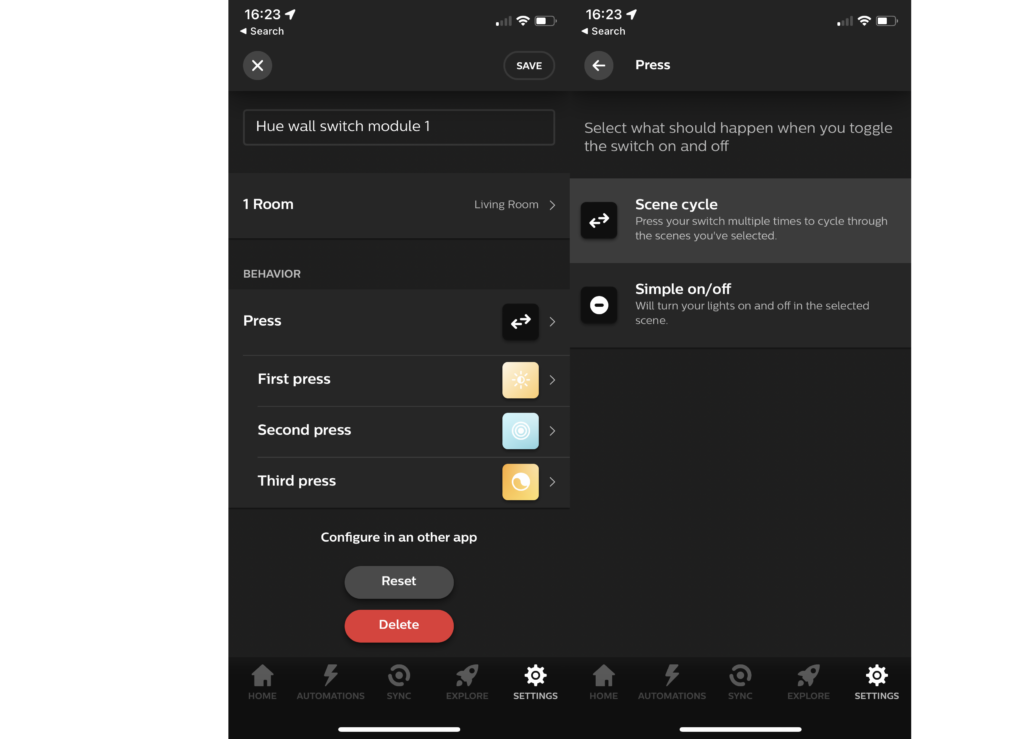
It gives some flexibility to the module, although note that you can’t get any dimming control with this device. In my living room, I use the Philips Hue Wall Switch Module behind the nice looking switch for on/off and basic scene selection. I’ve then got a Hue Dimmer Switch hidden out of sight that I use for dimming.
Apple HomeKit support is available, although you get less control here: you can only configure the Philips Hue Wall Switch Module for a single press. I wouldn’t bother setting the switch up in HomeKit.
As the Philips Hue Wall Switch Module works using Zigbee, it will still work even if your Wi-Fi goes down.
Performance
- Works reliably
- As good as your existing light switch
I’ve had the Philips Hue Wall Switch Module installed for well over a week now, and I’ve found that it works reliably each time. It’s as good as the other Hue switches, in fact. Even scene selection is easy enough, once I got used to the rhythm of turning the switch on and off.
Depending on how you control your lights, your light switch can reverse direction. For example, if you start by pressing your switch down to turn on your lights but then use the Hue app to turn the lights off, you then have to press your light switch up to turn your lights on.
For anyone that likes neatness and their light switches to work the same way each time, this product may annoy you; I really don’t care.
Latest deals
Should you buy it?
If you like your own light switches and have bought into the Hue ecosystem, then this is a good way to control your lights.
If you’ve got complicated multi-switch setups, this module may be difficult to install. It also gives less control than the other Hue switches.
Final Thoughts
It’s not perfect, and being battery operated may put some people off the Philips Hue Wall Switch Module. That said, for anyone that wants to keep power to their Hue bulbs and provide control via their attractive original light switches, this handy upgrade lets you do that. Ultimately, why Hue is so brilliant is because of the range of control options, and this switch just gives you more choice. For the right use and the right people (I count myself in this group), this module is brilliant.
How we test
Unlike other sites, we test every smart home product we review thoroughly over an extended period of time. We use industry standard tests to compare features properly. We’ll always tell you what we find. We never, ever, accept money to review a product.
Find out more about how we test in our ethics policy.
We test how each product integrates with other smart home systems including Amazon Alexa, Google Assistant, Apple HomeKit, IFTTT and Samsung SmartThings
We use each smart home product in a real world setting, integrating it into our home.
FAQs
Yes, but you’ll need one module per switch.
Each module can control two switches in the same housing.
Yes, it runs on a coin cell battery that should last around five years.

